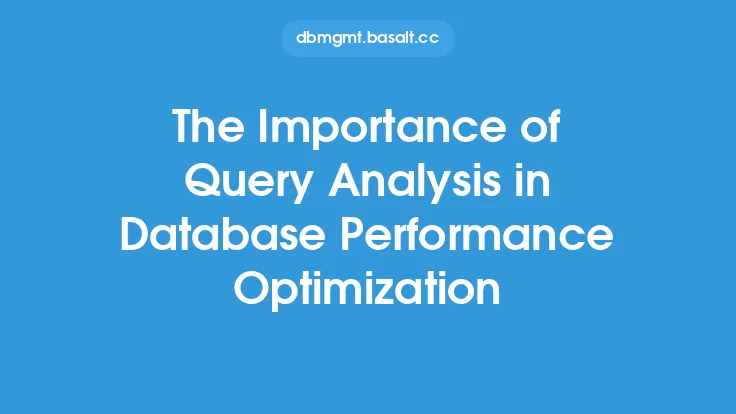Database optimization is a critical aspect of ensuring the overall performance and efficiency of a database. One of the key components of database optimization is the use of baseline statistics. Baseline statistics provide a snapshot of the database's performance at a particular point in time, allowing database administrators to identify trends, patterns, and areas for improvement. In this article, we will explore the importance of baseline statistics in database optimization and how they can be used to improve database performance.
What are Baseline Statistics?
Baseline statistics are a set of metrics that provide a baseline measurement of a database's performance. These metrics can include a wide range of data, such as query execution times, disk usage, memory usage, and network traffic. Baseline statistics are typically collected over a period of time, such as a day, week, or month, and are used to establish a normal operating range for the database. This normal operating range can then be used to identify deviations from normal performance, allowing database administrators to quickly identify and address performance issues.
Why are Baseline Statistics Important?
Baseline statistics are important for several reasons. First, they provide a historical record of database performance, allowing database administrators to track changes in performance over time. This can be useful for identifying trends and patterns in database usage, such as increased query execution times during peak usage periods. Second, baseline statistics provide a benchmark for measuring the effectiveness of performance optimization efforts. By comparing current performance metrics to baseline statistics, database administrators can determine whether optimization efforts are having the desired impact. Finally, baseline statistics can be used to identify potential performance issues before they become critical. By monitoring baseline statistics, database administrators can quickly identify deviations from normal performance and take corrective action before performance issues impact users.
How are Baseline Statistics Collected?
Baseline statistics can be collected using a variety of tools and techniques. One common method is to use database management system (DBMS) built-in tools, such as SQL Server's Dynamic Management Views (DMVs) or Oracle's Automatic Workload Repository (AWR). These tools provide a wide range of performance metrics, including query execution times, disk usage, and memory usage. Another method is to use third-party monitoring tools, such as Nagios or SolarWinds, which can collect performance metrics from a variety of sources, including DBMS, operating systems, and network devices. Baseline statistics can also be collected using custom scripts and programs, which can be tailored to meet the specific needs of the database.
What Metrics Should be Included in Baseline Statistics?
The specific metrics included in baseline statistics will depend on the database and the performance optimization goals. However, some common metrics that are typically included in baseline statistics include:
- Query execution times: This metric measures the time it takes for queries to execute, which can be useful for identifying performance bottlenecks.
- Disk usage: This metric measures the amount of disk space used by the database, which can be useful for identifying storage capacity issues.
- Memory usage: This metric measures the amount of memory used by the database, which can be useful for identifying memory capacity issues.
- Network traffic: This metric measures the amount of network traffic generated by the database, which can be useful for identifying network capacity issues.
- CPU usage: This metric measures the amount of CPU resources used by the database, which can be useful for identifying CPU capacity issues.
- Lock contention: This metric measures the amount of lock contention, which can be useful for identifying concurrency issues.
How are Baseline Statistics Used in Database Optimization?
Baseline statistics are used in database optimization to identify areas for improvement and to measure the effectiveness of optimization efforts. By comparing current performance metrics to baseline statistics, database administrators can quickly identify deviations from normal performance and take corrective action. For example, if query execution times are increasing, database administrators can use baseline statistics to identify the cause of the increase and take steps to optimize query performance. Baseline statistics can also be used to identify potential performance issues before they become critical. By monitoring baseline statistics, database administrators can quickly identify deviations from normal performance and take corrective action before performance issues impact users.
Best Practices for Collecting and Using Baseline Statistics
There are several best practices for collecting and using baseline statistics. First, baseline statistics should be collected regularly, such as daily or weekly, to ensure that the data is current and relevant. Second, baseline statistics should be stored in a secure and accessible location, such as a database or file system, to ensure that the data is available when needed. Third, baseline statistics should be analyzed regularly, such as monthly or quarterly, to identify trends and patterns in database performance. Finally, baseline statistics should be used to inform performance optimization efforts, such as query optimization or indexing, to ensure that optimization efforts are targeted and effective.
Common Challenges and Limitations
There are several common challenges and limitations associated with collecting and using baseline statistics. One common challenge is ensuring that the data is accurate and reliable, which can be difficult if the data is collected manually or using automated tools that are not properly configured. Another challenge is ensuring that the data is relevant and useful, which can be difficult if the data is not properly analyzed or if the analysis is not targeted to specific performance optimization goals. Finally, baseline statistics can be limited by the availability of data, which can be a challenge if the data is not collected regularly or if the data is not stored in a secure and accessible location.
Conclusion
In conclusion, baseline statistics are a critical component of database optimization, providing a snapshot of database performance at a particular point in time. By collecting and analyzing baseline statistics, database administrators can identify trends and patterns in database performance, measure the effectiveness of performance optimization efforts, and identify potential performance issues before they become critical. While there are several challenges and limitations associated with collecting and using baseline statistics, the benefits of using baseline statistics in database optimization make it a valuable tool for any database administrator. By following best practices for collecting and using baseline statistics, database administrators can ensure that their databases are running at optimal performance, which can have a significant impact on the overall efficiency and effectiveness of the organization.





